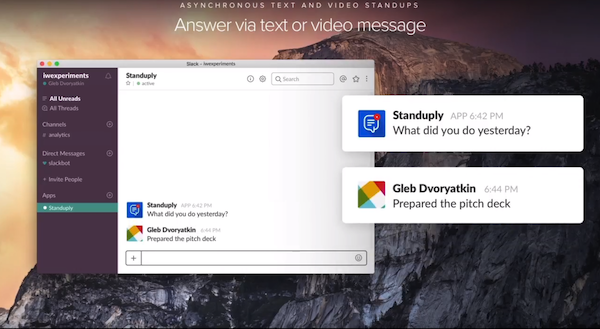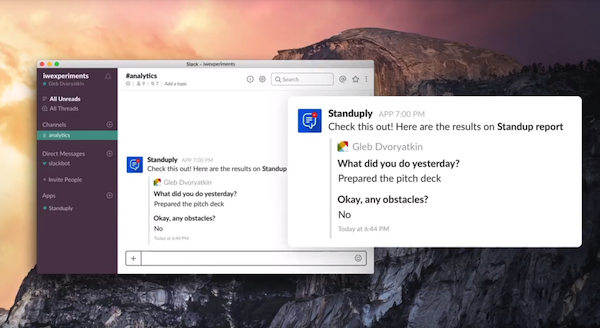Scrum meeting seems like an easy and effective practice. You get together with a team every day for 15 minutes to discuss the progress. But, Daily Scrum can really suck. If your Scrum meetings suck, there’s a good chance you are doing it wrong.

What is a Scrum Meeting (‘standup’)?
It’s a meeting Agile teams hold daily which is time-boxed to 15 minutes. During a Scrum meeting team members sequentially answer three questions: 1. What did you do yesterday? 2. What do you plan to do today? 3. Do you have any obstacles?
Daily Scrum is essential for Agile teams to coordinate the work and plan their day.
I was surprised one day to find that some developers hate Scrum meetings. How could that happen to a short and easy going meeting? Probably, it’s a result of poor team management skills and culture in their workplace.
There are businesses built solely on improving the Scrum meeting. Here’s our story how Standuply reached $25,000 in monthly revenues by helping remote teams to run asynchronous Scrum meetings on Slack.
To make standups great again, we prepared this guide on Scrum meetings. It includes years of our experience working with thousands of Agile teams.
Including great companies like:






Scrum Meeting Myths
Managing people is a complicated task, for sure. Managing remote team – twice as hard. So there a lot of myths about Agile and Scrum from calling standups an anti-pattern to Agile declared being dead. Mostly they come from a wrong understanding of Agile principles.
Agile is here to stay: see the Developer Survey Results by StackOverflow or explore Google Trends. And myths will be busted.
Myth #1 — Scrum meeting is for managers
Scrum Master and Product Owner don’t manage a development team. In Scrum, individual teams are responsible for software development and reaching sprint goals.
As team members work together on the product, everyone should be on the same page in regards to who’s working on and if there are any blockers.
Daily Scrum meetings are there for the problem-solving. They increase transparency and help to spot impediments. Thus, it’s the Scrum team who need a daily meeting.
Myth # 2 — Scrum meeting is a status meeting
This one comes together with the myth above. Few people like status meetings because they’re long, boring and about reporting. Since a Scrum team is self-organizing, there is no one to report.
Considering the mutual responsibility in Scrum, it’s everyone you’d like to keep informed about your progress and obstacles. The better a team member communicates, the faster the whole team will reach their sprint goals. Especially it’s much easier for remote employees to communicate with the team. Read our article on how to build a remote team and make no mistake!
Agile team members need to be informed and not reported. It’s one of the primary goals of a Scrum meeting.

Scrum Meeting Best Practices
Scrum requires dedication and management experience to run awesome standups. The big deal here is to make it right from the start.
Otherwise, your developers may lose faith in a Scrum meeting. Don’t you want them spreading the word how they hate Scrum meetings?

#1. Pick the right time for a Scrum Meeting
Timing matters a lot for several reasons.
First, you want a team to start their day with a Scrum meeting so that everyone is on the same page. If there are any blockers, everyone is informed, and the team is ready to tackle them right away.
Second, morning time is when people feel fresh and energized. It’s easy to dedicate 15 minutes of your time before work rather than in the middle of a hair on fire working day.
We, at Standuply, see the highest response rate for morning Scrums compared to meetings ran after lunchtime or in the evening. To get the best results, consider the earliest time that is convenient for all team members.

#2. Run asynchronous Scrum meetings in remote teams
When the whole team is in the same office, it’s easy to raise your hand and shout “stand up time!”. But if you have remote workers with their schedules and life routines, it becomes harder scheduling a recurring daily meeting with the whole team.
Meetings consistency declines with mismatched schedules. The more significant the time difference, the harder it gets. Today many teams are embracing the new way of doing stand-up meetings asynchronously looking for ways to make their meeting more effective.
Let me tell you how to run asynchronous standups on Slack. Shameless plug below.
You can use a Slack bot Standuply to gather responses from your team members. Standuply runs stand ups by reaching out to your team members in Slack and asking them questions you define.

Once team members provide their answers, the bot collects them and prepares an overall report for your team. Results can be delivered to a Slack channel or via DM, email or Webhook.

Agile is about being consistent. It is demanding, but consistency makes it work. That’s where bots like Standuply can help.
If you don’t use Slack, you can automate Scrum meetings via email using Daily Standup Meeting Excel Template we shared in another post on this blog.

#3. Stick to your schedule no matter what
The ultimate goal of a Scrum meeting schedule is to make it a habit, like brushing your teeth. That’s why the best practice is to make it at the same time in the same place every single working day of the sprint.
If you start shifting your schedules, it will take time and effort to find the timing which suits everyone. Team members will have to remember a new plan and stick to it. Rythm will be lost with productivity declining.
When you have no exceptions for a Scrum meeting schedule, it reduces complexity, becomes effortless and builds a productive rhythm for your Agile team.

#4. Align the team around the Sprint goal
Sprint goal setting is a useful technique. Tech blogs talk how important for a company to have a mission to align all the employees. The same applies to a Sprint. You don’t want to have a team being busy working on separate things without a vision.
Sprint goal also comes into play during Scrum meetings. During a daily Scrum shift the focus from “what I did” to “how did I progress towards a Sprint goal”.
Team members report on how their goals are progressing, rather than their levels of “busyness”. This way all the team members will be aligned by the same vision and focused on making it happen within a Sprint.

#5. Prepare a Scrum meeting agenda before the meeting
Here’s a quick and simple trick to improve productivity and make a Scrum meeting shorter.
Use Standuply bot on Slack with the same Scrum questions, but configure it up to deliver team answers right before a physical Scrum meeting.

It will force your team to think before a Scrum meeting about yesterday’s work and today’s plan. Also, team members see answers before a daily Scrum meeting which increases transparency. And don’t forget to use some icebreakers to arm your team up!
We found that teams that follow this practice decrease their time spent and greatly improve their transparency.

#6. Use daily Scrums to motivate the team
Your daily scrums should be energizing and fun. Your team should feel excited to work after each Scrum meeting. You don’t need loud music, don’t try to be a cheerleader. It’s not necessary. Team members need to know that their work is meaningful and valuable.
You can take a very brief moment to remind the team about the value of their work. Talk about users who will benefit from the stuff they are building and celebrate small victories by telling each other “good job” after a task is completed.
This can be hard in the daily grind because daily Scrum meetings are super repetitive. You won’t be able to create a super high energy level every day, and that’s ok. But generally speaking, your team should feel more motivated, not less motivated, after the Scrum meeting.

#7. Inform stakeholders and people who’re missing standups
Here’s another trick on how to improve your Scrum meetings for people who aren’t present. Sometimes you have stakeholders or people at PTO who need to be in the know.
To achieve that use Standuply bot with the same or slightly changed Scrum questions with the focus on information that should be delivered to stakeholders. Let your team answer those questions and configure the bot sending reports via email.

It doesn’t take too much effort and keeps external team members in the loop.
Scrum Meeting Anti-patterns

Even if you follow the best practices, it’s possible to fall into anti-patterns that will drastically reduce the productivity of your Agile team. At the same time, when you’re aware of them, it’s easy to avoid those situations and keep things on track.

#1 Waiting for latecomers to your Scrum Meetings
You have regular standups at 9 am, but one day Jane is “just two blocks away” missing the starting time. “Guys let’s wait for her and then start the daily Scrum,” you say. Ouch, you’ve just put a time bomb under your team’s productivity.
That meeting started 15 minutes later because Jane couldn’t find a parking lot. Then more people start coming late, and suddenly you have a daily Scrum at 9:30. The time between 9:00 and 9:30 is now wasted and team members that are coming on time are frustrated.
The one and the only way to avoid that scenario is to start a Scrum meeting at a scheduled time no matter what. Don’t let latecomers interrupt the meeting and don’t repeat anything for them. They have to be on time.
The daily Scrum by design is a meeting that can be run when someone is missing. At best, everyone is present, but if someone is late or absent, it’s not a stop factor.
It’s still true even if a Scrum Master is late or missing. Again, it’s the team who needs a daily Scrum. Why should they disregard a meeting if a Scrum Master is not there?
Being strict about the schedule creates a habit and teaches team members always be on time. The price of Jane coming to a meeting late is less than ruining the process of daily Scrum altogether.

#2 Lack of time-boxing at a standup meeting
A Scrum meeting ends 15 minutes after the start, even if someone hasn’t spoken. Period. It may sound counter-intuitive and even rude. But in the long run, the benefit is worth it.
Do you know why more teams turn to Standuply bot for text written standups on Slack? Their standups are long, boring which causes team demotivation. It’s complicated to reserve time for appointments after the daily Scrum if it’s duration varies.
The best way to avoid that is to stop a meeting 15 minutes after the start. “But what if some team members haven’t participated yet?” you ask. It’s doesn’t matter, just stop it. The price of missing those several people to say is less than excessive time spent and team’s demotivation.
There shouldn’t be any discussions during daily Scrum to keep it within 15 minutes. Everything that requires discussions should be left for separate meetings after a daily Scrum, i.e., if any problems arise. This way you exclude team members from irrelevant talks and keep the Scrum meeting short.
Educate your team about the importance of such an approach. Over time your team members will learn to be brief and 15 minutes will be enough for a daily scrum. The only exception could be a Scrum call with a remote team. In this case, set a timer for 20 minutes with first 5 minutes socializing.

#3 Skipping questions
Three Scrum questions is a framework that sets the ground for each team members’ input. They keep a team focus on inspecting, adapting and collaboration. Sometimes people skip questions (probably the 2nd and the 3rd).
Answering only the first question is a sign of a status meeting. Don’t let that happen in your team. The purpose of a daily Scrum is to improve collaboration. To make that happen others need to know what everyone will work on today.
Even if a person is working on the same task and doesn’t have any impediments, let her say it out loud. It’s valuable for a team to hear that, and also it’s uber important to stick with the format to keep the same flow every meeting.
Work with silent team members that have nothing to report. They still can go through three questions to inform others about their work and ideas. Let them comfortably speak, but don’t allow them to skip their turn.
Alternative ways to improve Scrum Meetings
We see how many Agile teams dedicate managing Scrum ceremonies to one of their team members. It’s not the best way to follow Scrum because it takes a lot of experience and dedication.
A good experienced Scrum Master can make a huge difference to the dynamics of your team. We prepared a set of Scrum Master Interview Questions if you’re looking to hire the one. If you can’t afford to hire a full-time Scrum Master, consider a Digital Scrum Master bot. It works 24×7, but not as intelligent as a human being (yet).
P.S. Read our new guide on running good retrospective meetings – Scrum Retrospective Teardown — Best Practices and Tools.
. . .
Do you want to ask for Artem’s advice? Here’s his profile at Standuply Mentors, reach out directly to me for any help you may need.


